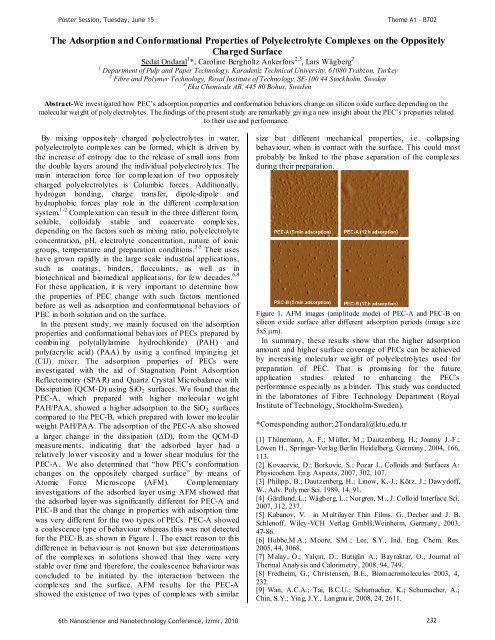Photonic crystals in biology
Photonic crystals in biology
Photonic crystals in biology
Create successful ePaper yourself
Turn your PDF publications into a flip-book with our unique Google optimized e-Paper software.
Poster Session, Tuesday, June 15<br />
Theme A1 - B702<br />
The Adsorption and Conformational Properties of Polyelectrolyte Complexes on the Oppositely<br />
Charged Surface<br />
Sedat Ondaral 1 *, Carol<strong>in</strong>e Bergholtz Ankerfors 2,3 , Lars Wågberg 2<br />
1 Department of Pulp and Paper Technology, Karadeniz Technical University, 61080 Trabzon, Turkey<br />
2 Fibre and Polymer Technology, Royal Institute of Technology, SE-100 44 Stockholm, Sweden<br />
3 Eka Chemicals AB, 445 80 Bohus, Sweden<br />
Abstract-We <strong>in</strong>vestigated how PEC’s adsorption properties and conformation behaviors change on silicon o xide surface depend<strong>in</strong>g on the<br />
molecular weight of polyelectrolytes. The f<strong>in</strong>d<strong>in</strong>gs of the present study are remarkably giv<strong>in</strong>g a new <strong>in</strong>sight about the PEC’s properties related<br />
to their use and performance.<br />
By mix<strong>in</strong>g oppositely charged polyelectrolytes <strong>in</strong> water,<br />
polyelectrolyte complexes can be formed, which is driven by<br />
the <strong>in</strong>crease of entropy due to the release of small ions from<br />
the double layers around the <strong>in</strong>dividual polyelectrolytes. The<br />
ma<strong>in</strong> <strong>in</strong>teraction force for complexation of two oppositely<br />
charged polyelectrolytes is Columbic forces. Additionally,<br />
hydrogen bond<strong>in</strong>g, charge transfer, dipole-dipole and<br />
hydrophobic forces play role <strong>in</strong> the different complexation<br />
system. 1-2 Co mplexation can result <strong>in</strong> the three different form,<br />
soluble, colloidaly stable and coacervate complexes,<br />
depend<strong>in</strong>g on the factors such as mix<strong>in</strong>g ratio, polyelectrolyte<br />
concentration, pH, electrolyte concentration, nature of ionic<br />
groups, temperature and preparation conditions. 3-5 Their uses<br />
have grown rapidly <strong>in</strong> the large scale <strong>in</strong>dustrial applications,<br />
such as coat<strong>in</strong>gs, b<strong>in</strong>ders, flocculants, as well as <strong>in</strong><br />
biotechnical and biomedical applications, for few decades. 6-9<br />
For these application, it is very important to determ<strong>in</strong>e how<br />
the properties of PEC change with such factors mentioned<br />
before as well as adsorption and conformational behaviors of<br />
PEC <strong>in</strong> both solution and on the surface.<br />
In the present study, we ma<strong>in</strong>ly focused on the adsorption<br />
properties and conformational behaviors of PECs prepared by<br />
comb<strong>in</strong><strong>in</strong>g poly(allylam<strong>in</strong>e hydrochloride) (PAH) and<br />
poly(acrylic acid) (PAA) by us<strong>in</strong>g a conf<strong>in</strong>ed imp<strong>in</strong>g<strong>in</strong>g jet<br />
(CIJ) mixer. The adsorption properties of PECs were<br />
<strong>in</strong>vestigated with the aid of Stagnation Po<strong>in</strong>t Adsorption<br />
Reflectometry (SPAR) and Quartz Crystal Microbalance with<br />
Dissipation (QCM-D) us<strong>in</strong>g SiO2 surfaces. We found that the<br />
PEC-A, which prepared with higher molecular weight<br />
PAH/PAA, showed a higher adsorption to the SiO 2 surfaces<br />
compared to the PEC-B, which prepared with lower molecular<br />
weight PAH/PAA. The adsorption of the PEC-A also showed<br />
a larger change <strong>in</strong> the dissipation (D), fro m the QCM -D<br />
measurements, <strong>in</strong>dicat<strong>in</strong>g that the adsorbed layer had a<br />
relatively lower viscosity and a lower shear modulus for the<br />
PEC-A. We also determ<strong>in</strong>ed that “how PEC’s conformation<br />
changes on the oppositely charged surface” by means of<br />
Atomic Force Microscope (AFM). Complementary<br />
<strong>in</strong>vestigations of the adsorbed layer us<strong>in</strong>g AFM showed that<br />
the adsorbed layer was significantly different for PEC-A and<br />
PEC-B and that the change <strong>in</strong> properties with adsorption time<br />
was very different for the two types of PECs. PEC-A showed<br />
a coalescence type of behaviour whereas this was not detected<br />
for the PEC-B, as shown <strong>in</strong> Figure 1. The exact reason to this<br />
difference <strong>in</strong> behaviour is not known but size determ<strong>in</strong>ations<br />
of the complexes <strong>in</strong> solutions showed that they were very<br />
stable over time and therefore, the coalescence behaviour was<br />
concluded to be <strong>in</strong>itiated by the <strong>in</strong>teraction between the<br />
complexes and the surface. AFM results for the PEC-A<br />
showed the existence of two types of complexes with similar<br />
size but different mechanical properties, i.e. collaps<strong>in</strong>g<br />
behaviour, when <strong>in</strong> contact with the surface. This could most<br />
probably be l<strong>in</strong>ked to the phase separation of the complexes<br />
dur<strong>in</strong>g their preparation.<br />
Figure 1. AFM images (amplitude mode) of PEC-A and PEC-B on<br />
silicon oxide surface after different adsorption periods (image size<br />
5x5 m).<br />
In summary, these results show that the higher adsorption<br />
amount and higher surface coverage of PECs can be achieved<br />
by <strong>in</strong>creas<strong>in</strong>g molecular weight of polyelectrolytes used for<br />
preparation of PEC. That is promis<strong>in</strong>g for the future<br />
application studies related to enhanc<strong>in</strong>g the PEC’s<br />
performance especially as a b<strong>in</strong>der. This study was conducted<br />
<strong>in</strong> the laboratories of Fibre Technology Department (Royal<br />
Institute of Technology, Stockholm-Sweden).<br />
*Correspond<strong>in</strong>g author: 2Tondaral@ktu.edu.tr<br />
[1] Thünemann, A. F.; Müller, M.; Dautzenberg, H.; Joanny J.-F.;<br />
Löwen H., Spr<strong>in</strong>ger-Verlag Berl<strong>in</strong> Heidelberg, Germany, 2004, 166,<br />
113.<br />
[2] Kovacevic, D.; Borkovic, S.; Pozar J., Colloids and Surfaces A:<br />
Physicochem. Eng. Aspects, 2007, 302, 107.<br />
[3] Philipp, B.; Dautzenberg, H.; L<strong>in</strong>ow, K.-J.; Kötz, J.; Dawydoff,<br />
W., Adv. Polymer Sci. 1989, 14, 91.<br />
[4] Gärdlund, L.; Wågberg, L.; Norgren, M., J. Colloid Interface Sci.<br />
2007, 312, 237.<br />
[5] Kabanov, V. <strong>in</strong> Multilayer Th<strong>in</strong> Films. G. Decher and J. B.<br />
Schlenoff, Wiley-VCH Verlag GmbH,We<strong>in</strong>heim, Germany, 2003,<br />
47-86.<br />
[6] Hubbe,M.A.; Moore, S.M.; Lee, S.Y., Ind. Eng. Chem. Res.<br />
2005, 44, 3068.<br />
[7] Malay, Ö.; Y O., Journal of<br />
Thermal Analysis and Calorimetry, 2008, 94, 749.<br />
[8] Fredheim, G.; Christensen, B.E., Biomacromolecules 2003, 4,<br />
232.<br />
[9] Wan, A.C.A.; Tai, B.C.U.; Schumacher, K.; Schumacher, A.;<br />
Ch<strong>in</strong>, S.Y.; Y<strong>in</strong>g, J.Y., Langmuir, 2008, 24, 2611.<br />
6th Nanoscience and Nanotechnology Conference, zmir, 2010 232













